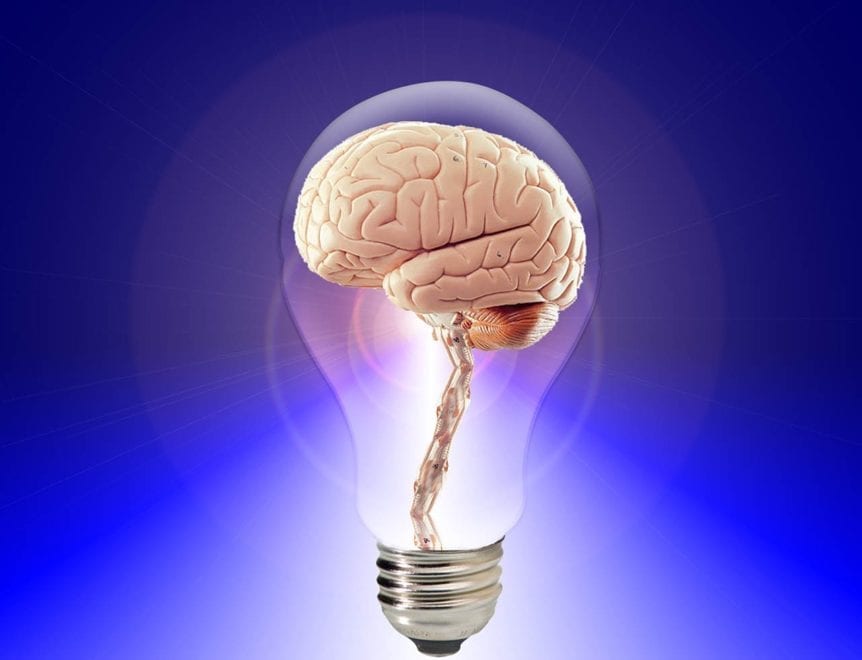Russell Jaffe, MD, Ph.D., CCN
A sustainable brain responds to life with resilience and learned optimism. From mood stability to mobility, from senses to sensibility there is much we can do to add years to life and life to years. This is a brief user’s guide and contemporary update about how to have a healthy brain for life and how to improve or recover function when needed. First, we review the functions of your brains and then our synthesis of keeping your brain tuned up for life.
Brains: CNS and GNS
Brains, both Central and Intestinal, are responsible for how well we comprehend, concentrate, feel, remember, understand and interact with the outside world. Neurohormones and neurochemicals are produced by and influence brain function and performance. Constant communion between the gut and the central nervous systems occurs through the Vagus nerve, recently confirmed to be bi-directional.
Brains thrive on intense balanced intake of nature’s nutrients; these nutrients are referred to as essential because the body cannot make them on its own. Later in this article, there are suggestions of predictive tests and a suite of 21stcentury supplements for lifelong healthy brains.
Proactive and predictive primary prevention practicesfor brain health.
Essential fat replenishment
The white matter in your brain is ~30% DHA, an essential Omega 3 fat. You need DHA for brain and body and you need EPA for body and brain. The best source for both is marine lipid distilled under nitrogen to remove mercury and other toxic minerals as well as solvent residues that can build up in fish oil, even in those from cold-water sources. Nitrogen also protects the delicate fats from oxidation by substances in the air that harm essential fats.
The amounts needed have risen over the last decades. Experts currently recommend 3 or more grams daily of EPA and DHA from both fatty fish in the diet as well as supplements. Micellized softgels provide better bioavailability, ease of uptake and extend product shelf-life.
What about ALA
The desaturase enzymes needed to convert ALA into EPA and DHA are often inhibited or down regulated. This means it is important to take a high-quality EPA + DHA micellized supplement that provides active essential fats for immune defense and repair modulation and better neurohormone functions. While ALA from flax or hemp seeds is OK to consume, its conversion to EPA is too often greatly limited.
Edible Oils: Just Say No
Reducingor eliminating edible oils and fried, crisps or chip foods lowers excess Omega 6 fat intake and can restore a healthy balance between Omega 3 and Omega 6. An Omega 3 indexis helpful to determine Omega 3 to Omega 6 balance. The healthiest people globally take in a balance of Omega 3 and Omega 6 fats from whole foods that are easier to digest, assimilate and eliminate.
In addition, to reduce insulin resistance, metabolic syndrome, obesity and diabetic complications, take in 20% each of fat and protein plus 60% nutrient rich fiber (complex carbs from plants).
Essential antioxidant protection from oxidative stress and ‘aging’
Much of what is known as agingis the gradual depletion and lack of repletion of essential nutrients and co-factors. Further, cumulative repair deficits due to imbalanced intake of essential nutrients are more commonly known as inflammation. From Ascorbate to full B Complex to carotenoids to tocopherols and tocotrienols to selenomethionine, the healthy brain needs protection from nutrient depleting substances that can be present in the diet, beverages and environment.
Ascorbate is the ‘mother’ antioxidant that sacrifices herself so that others can be regenerated, conserved and better utilized. Always use only recrystallized under nitrogen, 100% l-ascorbate, fully buffered and fully reduced. This is nature’s ascorbate.
We suggest a personal ‘C Cleanse’to determine how much oxidative burden and therefore how much antioxidant protection a person needs. A weekly C Cleanse helps people repair, reduces oxidative toxic burdens more safely, and helps people survive and be well in the stress and toxin-rich 21stCentury.
Ascorbic acid or commercial vitamin C is synthetic and only a small fraction is helpful. This means a cheap price and a low value product that is actually expensive compared to benefits from fully buffered and reduced l-ascorbate. Synthetic ascorbate can build up in the intestines and irritate the gut.
Vitamin E, glutathione, lipoic acid, taurine, FAD and NAD are among the protective molecules that l-ascorbate both regenerates and functionally enhances synthesis (renewal).
Comprehensive B complex intake using nature sources including hydroxocobalamin (nature’s B12), PABA, pantothenate and folate is recommended. B complex sufficiency is confirmed when people have a sunshine yellow urine. The glass clear urine of many people indicates functional B complex deficit. Muddy or yellow brown urine may indicate dehydration; need for more water or herbal beverages.
Carotenoids are a large family of molecules. Each has a specific functional benefit and preferred location in the body. From lycopene to lutein, from alpha- to beta-carotene, from zeaxanthin to cryptoxanthin a wide variety of colorful fruits and vegetables provides carotenoids. Supplementation with full spectrum carotenoids is recommended. High dose beta-carotene is not recommended. Quercetin dihydrate and soluble OPC are the recommended polyphenolics.
Tocopherols and tocotrienols, of which there are four of each, along with selenomethionine play an essential role in preventing free radical oxidative damage to cell membranes.
Healthier hearts and vascular systems benefit from 400 to 3600 IU daily of tocopherols and tocotrienols. Selenomethionine is required for the benefits of vitamin E to capture and transfer to ascorbate electrons liberated during triglyceride metabolism so that they do not become harmful free radicals.
Essential minerals to neutralize excess acids and recharge the cell
‘Cells are acidic in design yet alkaline in function’ quipped Albert Szent-Gyorgy. He isolated ascorbate from Hungary paprika. He then contributed so much to understanding how muscles work that he was awarded the Noel Prize. He was one of my many mentors.
Minerals, especially magnesium, need to be taken in from diet and supplements, sufficient to keep cell energetics high and to protect essential fats in transport. For ATP to provide energy to cells, each ATP molecule needs one magnesium. This means that magnesium deficits induce cell energy fatigue that can have a variety of adverse consequences medically as accelerated chronic illness.
Cell enzyme catalysts are exquisitely sensitive to small changes in pH (acid to alkaline relationship). Accuracy and efficiency of protein production and metabolism depend upon a regular replenishment of minerals, particularly magnesium, zinc and potassium. We recommend them with Krebs’s energy counter ions such as fumarate, citrate and succinate. The common acidic forms from chlorides to sulfates to oxides or ground up mineral rich rocks are better avoided.
Checking urine pH after 6 hours of rest provides a daily indication of our acid – alkaline balance. Preferred urine pH in the morning is 6.5-7.5, with lower numbers showing increasing net acid excess and indicating a need to eat more ‘alkaline’ foods and increase intake of magnesium rich supplements. Choline Citrate uniquely enhances ionized magnesium uptake and chaperones delivery to cells needing buffering mineral’s protection and activation.
First morning urine pH numbers above 7.5 indicate possible catabolic illness.
Meaningful work
Doing something meaningful is important in a life well lived and for a lifetime of brain health. If you can’t do what you love at least love what you do. Gardening, dancing, ambling in nature and hiking are recommended examples.
Restorative sleep and dreams
During different seasons of a life, different sleep rhythms can occur. Adequaterestorative sleepincluding dreams (Rapid eye moment or REM intervals) is essential for mental health, mood stability and brain renewal. While important for all humans, restorative sleep is particularly important for the young and the long lived.
It helps to have a firm mattress. A futon on the floor or a latex or similar adaptive mattress improves restorative sleep for many people. The darker the bedroom the better. My suggestion is neither digital screens nor devices in the bedroom.
Lack of restorative sleep has adverse consequences on mood, productivity and problem solving. Watch my recent webinar about using physiology before pharmacology for restorative sleep and enhanced mood. Watch Now
Pre-sleep salt & soda bath
Part of self-care is preparing with quality sleep. Many people find that a salt and soda bathis both relaxing and health promoting.While in the bath, abdominal deep, slow breathing for 5 minutes and some form of mindfulness practice or being more fully in the moment are encouraged. This relaxation response can be coupled with the next suggestion, dichromatic green light.
Green dichromatic light
One level of the retina is wired directly into the pineal gland in the deep brain. If the pituitary is the master gland, the pineal is the mistress of the pituitary, mediated through the thalamus. Green frequencies,as generated uniquely by PAR 38 dichromatic 150 watt lights, help restore, renew and enhance neurohormonal balance.
Relaxation response / active meditation
Mindfulness studies have confirmed that a few minutes twice daily can dramatically improve mental and physical health. Mind and body are always intimately connected. This is shown in the bidirectional nature of the vagus nerve connection between the central and visceral nervous systems. Learned optimism and ability to appreciate the opportunities we are given emerge from regular active meditationpractice.
It is increasingly clear that anything we devote 10,000+ hours to changes brain function in response to the particular physical or mental practice. Choose wisely; perseverance furthers success.
Phosphatides
From phosphatidylcholine to phosphatidylserine, phosphatides are quaternary amines that enable uptake especially when they are used in advanced micellized softgels, enhanced uptake and chaperoned delivery of cofactors like CoQ10 to minerals like magnesium to tocopherols to omega 3 fats to a variety of herbs.
Botanicals
A few plants have traditionally been used to improve memory or other brain functions. Vinpocetine from periwinkle and gingko biloba as well as various ginsengs are examples that have been extensively studied. Standardized concentrates of natural products are recommended. Synthetic work-a-likes are less safe and less effective.
Additions and Options to Support Brain Health (see also Sidebar below):
- Lucid dreamingSome people can learn to be aware while dreaming. This allows people to be active within their dream time.
- Breathing exercisesFrom pranayama yoga practices to breathing in Tai Chi to many contemplative techniques, a quieting breathing practiceis both an induction to peaceful contemplation and a place of mental refuge in afflictive circumstances.
- Amino acids for moodThree simple, synergistic amino acids are remarkably helpful in helping people think more clearly and get more benefit from anything else they are doing or feeling. The amino acids are methionine, glycine and magnesium aspartate. Each is known to be helpful to neurochemical and detoxification functions inside brain and other cells. Glycineis also a stabilizing neurotransmitter along with being a simple protein building block amino acid.
- Functional tests of brain function that can be efficiently tested include:
- Self assessments include digestive transit time, hydration status, antioxidant need / oxidative burden (C Cleanse)and urine pHafter rest to assess cell mineral needs such as magnesium to redress net metabolic acid excess.
- Predictive biomarkersthat cover all of epigenetics through eight tests interpreted compared to best outcome goal values rather than usual or normal lab ranges.
- Salivary stress and other hormonesto include cortisol and DHEA at four different times within a day along with estrogens (female hormones) and androgens (male hormones) along with their precursors.
- Assessment of essential and toxic mineralsthrough d-penicillamine provocation using 24º urine collections.
Scans and Images
There are many scans that can be done. From Functional MRIs to high resolution CT and PET scans, the interpretation of the scan can be helpful in ruling out certain problems yet remains quite limited in regard to revealing how well the brain is functioning and adapting. Neuroscience is learning how adaptive and changing is the adult human brain. Needed are new technologies with even better ability to assess nerve cell energetics, oxidative toxin burden and stress resilience. Many assume incorrectlythat nerve cells to not divide, however, new brain cells sprout when the nervous systems are in an energetic, alkaline nutrient rich cell environment including in people who have lived long.
Having had my dad until he was 90 and my teacher, Bhanté Dharmawara, until he was 110, it has been my privilege to observe healthy highly functional brains in elders dear to me. In both cases, I had the privilege of helping them recover fully from significant stroke events. My Dad had his stroke in my living room. He quickly went into brain stem (Cheyne-Stokes) breathing. Assuming he would pass, I chose palliative care. After nine months of attentive care, Dad was ready to return to his condo and independent living. After that event, he would often comment that every day was, ‘the best day of my life’. In Bhanté’s case, the stroke occurred while he was away. He stayed for half a year with his students in Potomac, Maryland near where I live. Again, his recovery was complete as was his confidence that effort on his part would be rewarded as replenished and restored strength, endurance, and brain were.
References:
- Jaffe R and Mani J, Predictive Biomarkers: Clinical Opportunity to Save Lives and Prosper Townsend Letter for Doctors and Patients. 2018, Jan (414): 25-26
- Lord LD, Expert P,Huckins JF,Turkheimer FE.Cerebral energy metabolism and the brain’s functional network architecture: an integrative review. J Cereb Blood Flow Metab.2013 Sep;33(9):1347-54
- Jaffe R and Mani J. Polyphenolics Evoke Healing Responses: Clinical Evidence and Role of Predictive biomarkers. In: Polyphenols in Human Health and Disease, Second Edition, Volume 1,Watson RR, Preedy VR and Zibadi S (Eds) Academic Press, 2018: p 403-413.
- Fernando Gomez – Pinilla. Brain foods: the effects of nutrients on brain function. Nature Reviews Neuroscience. 2008Volume 9, pages 568–578.
- Davidson RJ, Lutz A. Buddha’s Brain: Neuroplasticity and Meditation. IEEE Signal Process Mag. 2008;25(1):176-174.
Sidebar: Supplements summary for 21stcentury luminous brain at all ages
- EPA + DHA fish oil in protected, micellized soft gel (3+ grams/day).
- Super-multi supplement with 40 active components in safer forms sufficient to keep urine sunshine yellow.
- Fully buffered and reduced l-ascorbate with balance of minerals
(potassium, calcium, magnesium and zinc) based on a C Cleanse. - Polyphenolics (4+ grams quercetin dihydrate flavonoid and soluble Orthoproanthocyanidin [OPC] flavanol)
- Carnitine fumarate with GABA (gamma-amino-butyrate) in micellized softgel to enhance fat metabolism.
- Co-enzyme Q10 and Vitamins E (tocopherols and tocotrienols) micellized in 100% rice bran oil (200-600 mg/day)
- Tryptophan enhanced with zinc and B6 to facilitate uptake and delivery of serotonin for restorative sleep and melatonin levels where needed in the brain for pineal and pituitary benefits.
- Methionine, glycine and magnesium aspartate for better sleep and mood
- Triple detoxifier and/or liver protection supplement (1-2 softgels AM & PM)
- Insulin resistance, blood sugar regulation and weight all benefit from multi-herb micellized softgels and also include safer forms of chromium such as citrate or picolinate as well as vanadium to help independently regulate sugar metabolism (intake based on blood sugar levels or sufficient to keep hemoglobin A1c <5%.
Did you enjoy this post? We post new content regularly! Click here to see our latest blog posts.




